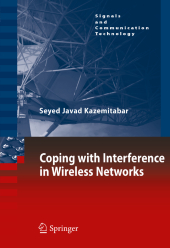 Neuerscheinungen 2014Stand: 2020-02-01 |
Schnellsuche
ISBN/Stichwort/Autor
|
Herderstraße 10
10625 Berlin
Tel.: 030 315 714 16
Fax 030 315 714 14
info@buchspektrum.de |

Seyed Javad Kazemitabar
Coping with Interference in Wireless Networks
2011. 2014. xv, 102 S. 235 mm
Verlag/Jahr: SPRINGER NETHERLANDS; SPRINGER 2014
ISBN: 9400799780 (9400799780)
Neue ISBN: 978-9400799783 (9789400799783)
Preis und Lieferzeit: Bitte klicken
This study of the effects of interference-and methods of coping with it-in a wireless network tackles the physical layer method as well as optimal routing scheduling and power control. The text also analyzes the connectivity of fading ad-hoc wireless networks.
Unlike wired networks where transmitters have no effect on receivers other than their own, in wireless networks we are limited by interference. The traditional routing methods are not optimal any more when it comes to a wireless medium. The maximum data rate on each link depends not only on the power in that link but also on the transmitted power from adjacent links. That is why the problem of power optimal routing needs to be solved jointly with scheduling. This suggests a cross layer design method as opposed to traditional networking where the algorithm for each layer is designed separately. In Coping with Interference in Wireless Networks we introduce several methods engaging different layers of network to mitigate interference in a wireless network.
Dedication. List of Figures. List of Tables. Foreword. Preface. Acknowledgements.
1 Introduction. Coping with Interference in Physical Layer. Coping with Interference in Medium-Access Control (MAC) Layer. Effect of Interference on Connectivity.
2 Multi-User Communication and Interference Cancellation. The Channel Model. Interference Cancellation Using Space-Time Block Coding. Interference Cancellation Using Quasi-Orthogonal Space-Time Block Coding. Interference Cancellation Using Minimum Decoding Complexity Quasi-Orthogonal Space-Time Block Codes (MDC-QOSTBC). Application of the New Interference Cancellation Scheme in Array Processing. Simulation Results.
3 Diversity Analysis of Multiple-Antenna Multi-User Systems. Diversity Order in a Communication Scheme. Multi-User Detection Using Alamouti. Multi-User Detection for More than Two Transmit Antennas. Joint Array Processing and Space-Time Coding. Discussion.
4 Global Optimal Routing, Scheduling and Power Control for Multi-hop Wireless Networks with Interference. Modeling and Problem Formulation. Power Control, Scheduling and Routing Algorithm. Nonlinear vs. Linear. Simulation Results and Discussion.
5 Connectivity in Wireless Networks. The Capacity Metric. The SER Metric. Capturing Temporal Correlation of Ergodic Channels. Experimental Verification of Analysis.
References. Index.


